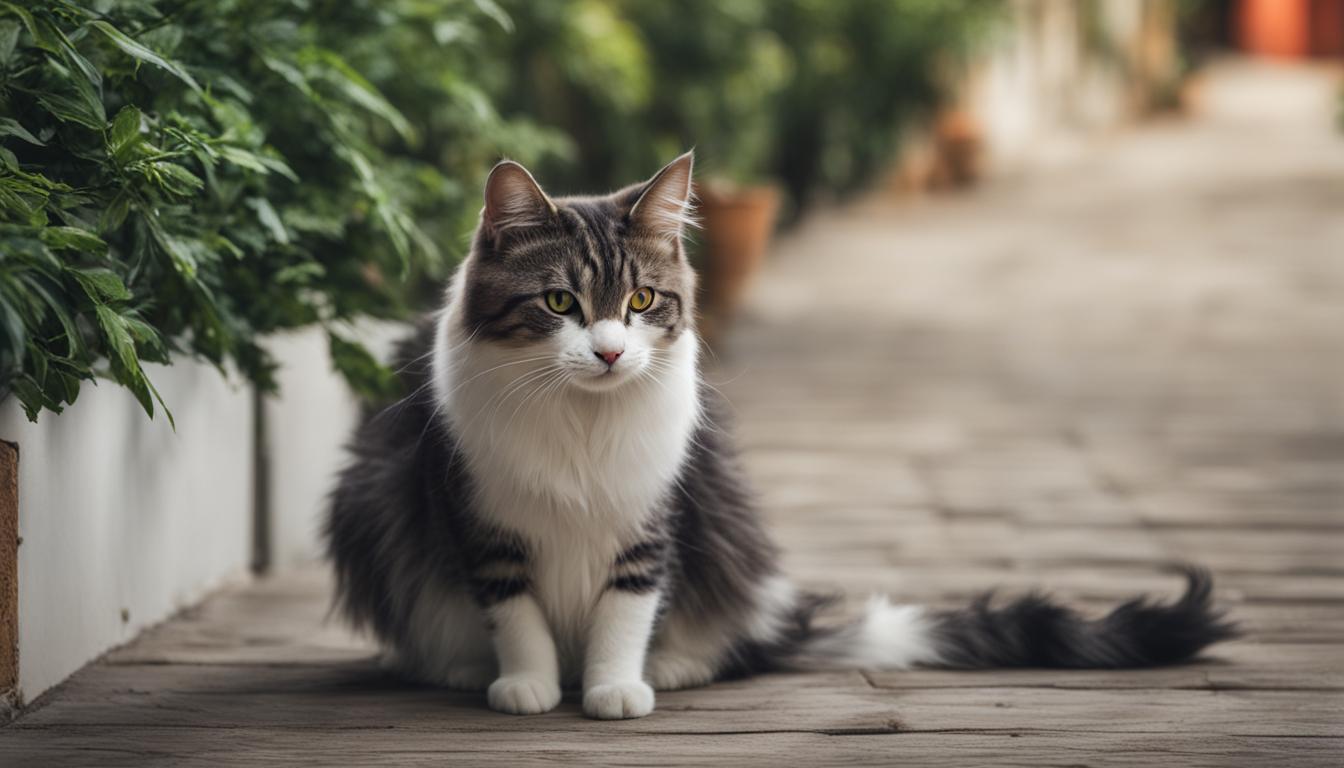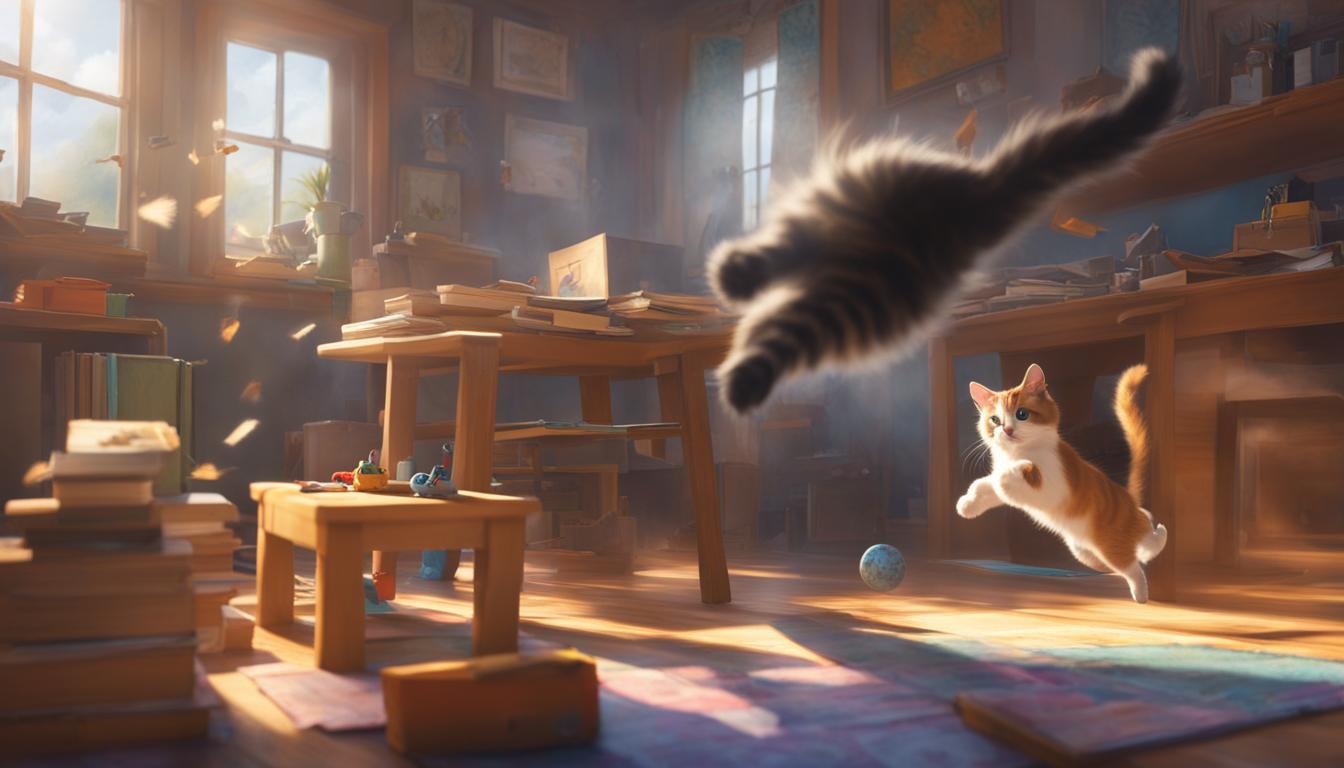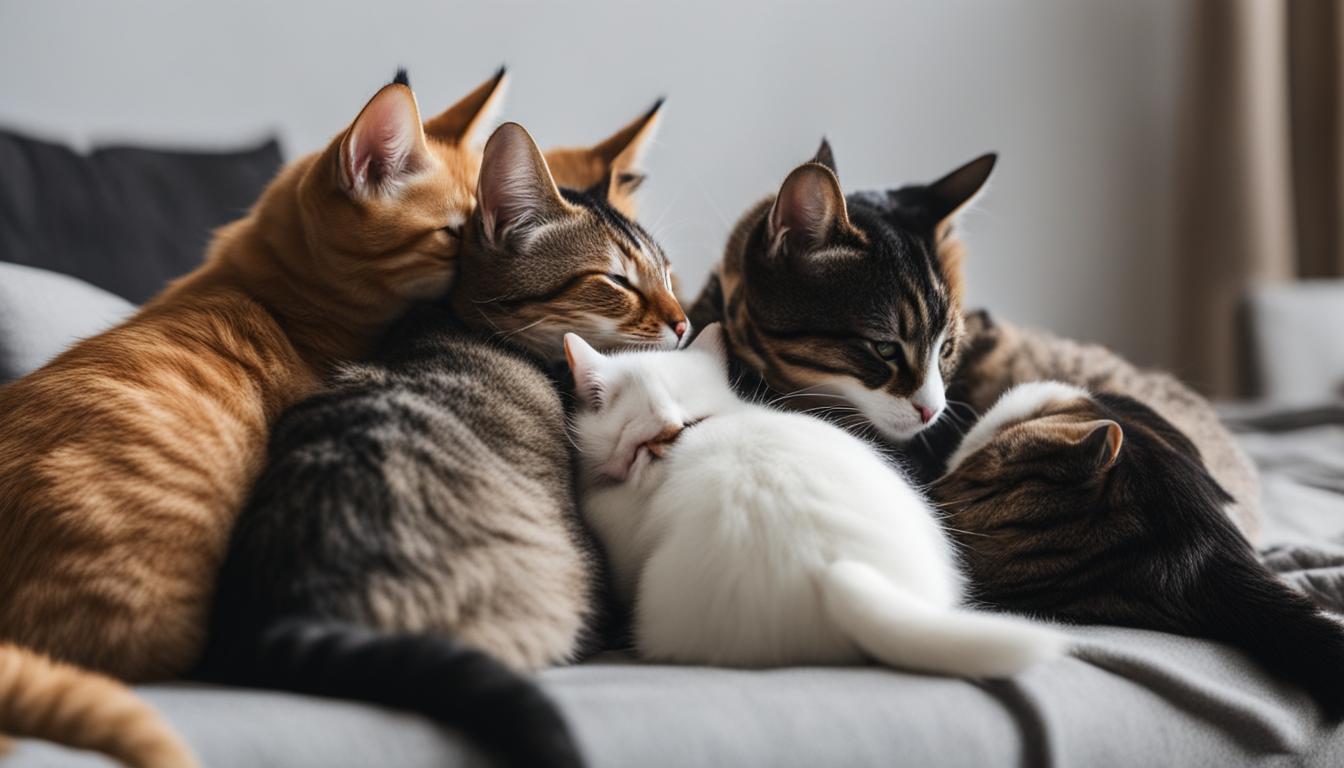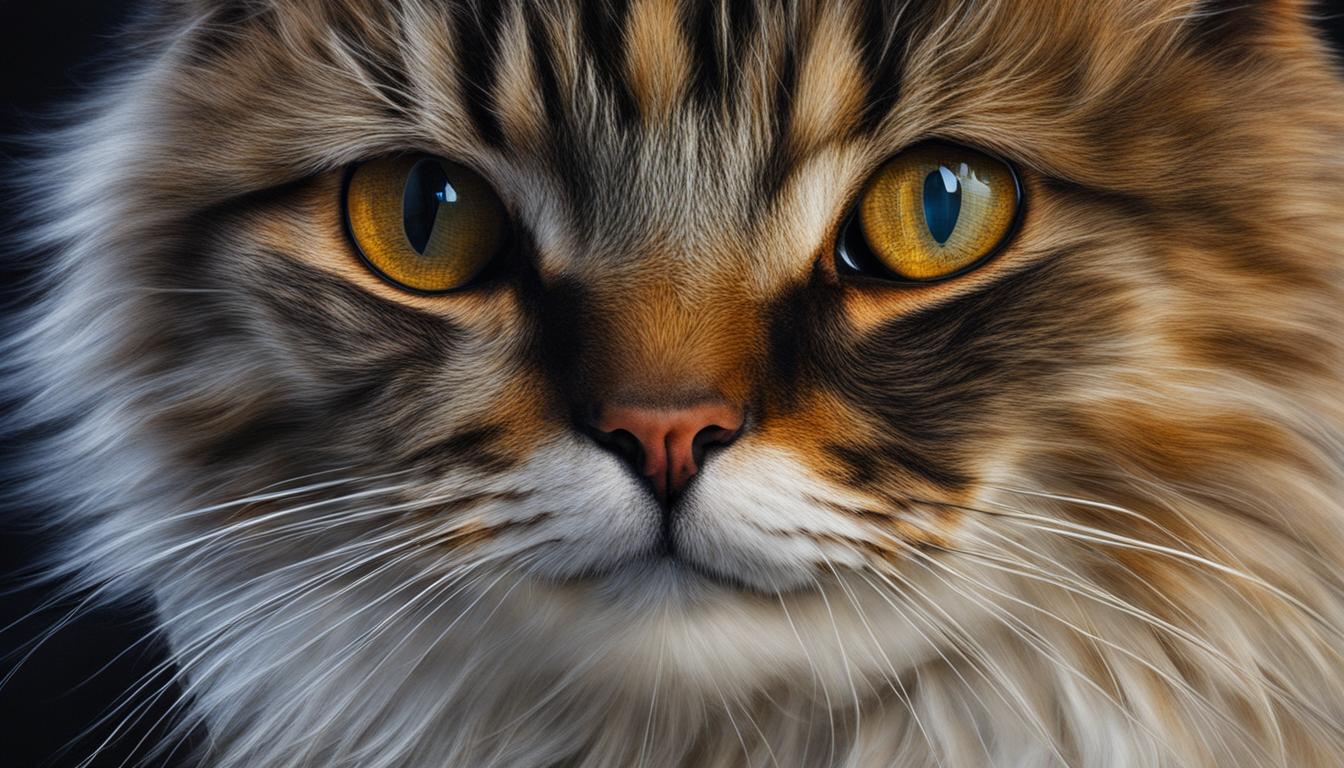Playtime is not just a frivolous activity for cats – it plays a crucial role in their overall well-being. As a cat lover and owner, I have witnessed firsthand the positive impact that play has on my feline companions. From physical exercise to mental stimulation, play provides a range of benefits that contribute to a happy and healthy cat. In this article, I will delve into the importance of play for cats, explore the benefits it offers, and provide recommendations for interactive cat toys that can enhance your cat’s playtime experience.
Key Takeaways:
- Play is essential for the mental and physical well-being of cats.
- Interactive cat toys stimulate hunting instincts and provide exercise.
- Monitor your cat during play to prevent ingestion of non-food toys.
- Rotate and provide a variety of toys to maintain your cat’s interest.
- Establish playtime routines and adapt them to suit your cat’s natural activity rhythms.
Choosing the Right Toys for Your Cat
When it comes to buying toys for your cat, it’s important to choose ones that cater to their natural hunting instincts. Look for toys that can be hunted, sought, attacked, and carried. These interactive toys not only provide mental stimulation but also help keep your cat physically active.
Some popular choices for interactive play include wand toys and battery-operated toys. Wand toys, like fishing pole toys, allow you to simulate the movements of prey, engaging your cat’s hunting instincts. However, it’s important to never leave these toys unattended, as they can pose a safety risk.
“Cats are natural hunters, and interactive play toys that mimic their prey are the best way to engage them in play.”
Battery-operated toys, on the other hand, can provide entertainment for your cat when you’re not available to play with them. These toys often have built-in movements or sounds that simulate prey, keeping your cat engaged and entertained.
Novelty in Cat Toys
In addition to choosing toys that cater to your cat’s hunting instincts, it’s important to provide novelty by rotating toys and offering a variety of options. Cats can quickly lose interest in the same toys, so keeping their toy collection fresh and exciting is key.
- Rotate toys regularly to maintain your cat’s interest
- Offer a variety of textures, shapes, and sizes
- Introduce new toys periodically to keep playtime engaging
By providing a mix of toys that stimulate different senses, your cat will be more likely to stay engaged and entertained during playtime.
| Toy Type | Description |
|---|---|
| Wand Toys | Fishing pole-style toys with feathers or other attachments. Mimic the movements of prey. |
| Battery-Operated Toys | Toys that move or make sounds on their own. Simulate the actions of prey. |
| Catnip Toys | Stuffed toys containing catnip, which can provide added stimulation for cats that respond positively to it. |
| Interactive Puzzle Toys | Toys that challenge cats to retrieve treats or solve puzzles for rewards. Provide mental stimulation. |
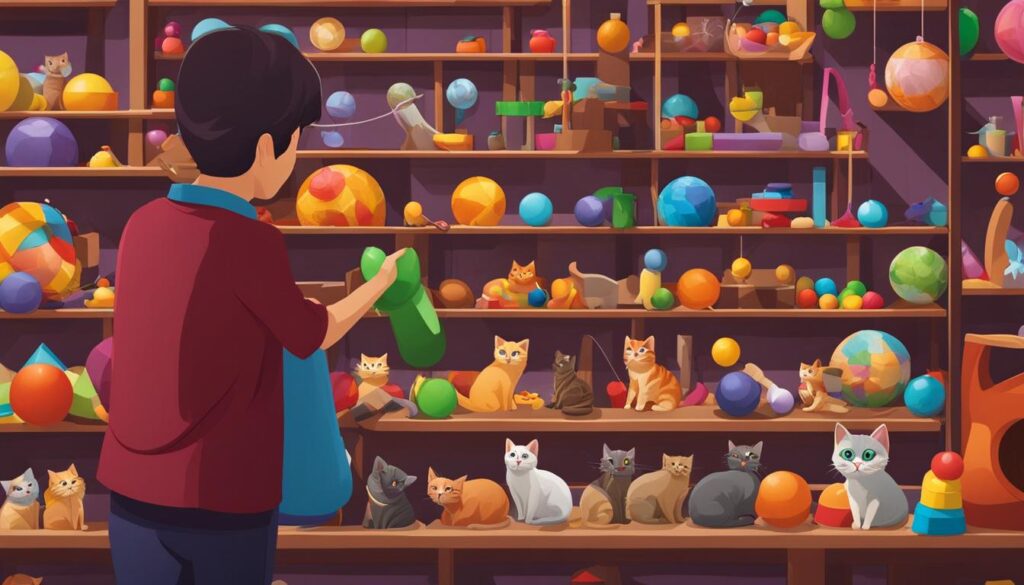
The Benefits of Play for Cats
Play is not just a fun activity for cats; it also has numerous benefits for their mental and physical health. Regular playtime is essential to ensure that cats stay happy and content. Let’s explore the various benefits of play for our feline friends:
1. Mental Stimulation:
Play provides cats with much-needed mental stimulation. Interactive play toys engage their natural hunting instincts and challenge their problem-solving skills. This mental exercise helps keep cats sharp and prevents boredom and destructive behavior.
2. Stress Relief:
Play is a great outlet for releasing pent-up energy and reducing stress in cats. It allows them to indulge in physical activity and provides an opportunity to release any tension or anxiety they may be experiencing.
3. Physical Exercise:
Regular play sessions provide cats with the exercise they need to stay fit and healthy. Through play, cats can stretch their muscles, improve their agility, and maintain a healthy weight. This is particularly important for indoor cats who may not have the opportunity to engage in natural physical activities like hunting or climbing trees.
Overall, playtime is an essential part of a cat’s routine and should be incorporated into their daily schedule. By engaging in play, cats can experience mental stimulation, stress relief, and physical exercise, leading to improved overall well-being.
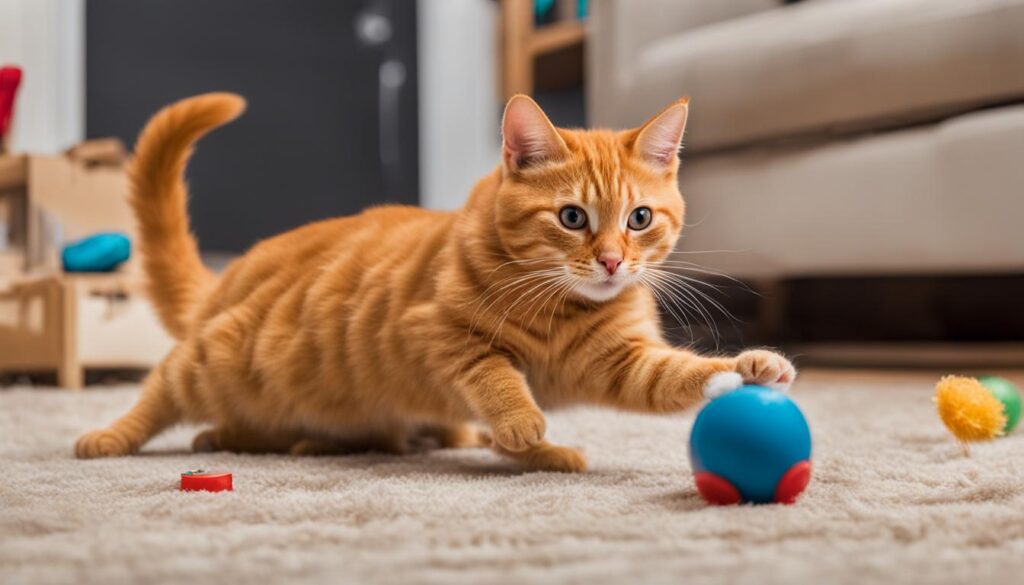
Interactive Play Toys for Cats
Cats are natural hunters, and interactive play toys are a fantastic way to engage their instincts and keep them mentally stimulated. These toys allow cats to stalk, chase, and “kill” their prey, providing a sense of fulfillment and satisfaction. Wand or fishing pole toys are excellent options for interactive play, as they can be used to simulate natural hunting behavior. These toys typically feature various attachments, such as feathers, cardboard, or felt, to add variety and keep cats engaged.
Puzzle toys are another great option for interactive play. These toys challenge cats to retrieve treats through openings or by solving puzzles, engaging their minds and encouraging problem-solving skills. Puzzle toys provide mental stimulation and help prevent boredom in cats. It is essential to choose toys that appeal to your cat’s senses, such as sight, sound, scent, touch, and taste. Each cat may have specific preferences, so it may take some trial and error to find the toys that best stimulate them.
In addition to interactive and puzzle toys, fishing pole toys are also popular among cats. These toys typically feature a fishing rod-like handle with a string or elastic cord attached to a toy or feather at the end. Cats love to chase and pounce on the moving toy, mimicking the behavior of catching prey. Fishing pole toys provide both mental and physical stimulation and can be a great way to bond with your cat through play.
To summarize, interactive play toys, puzzle toys, and fishing pole toys are excellent choices for engaging cats in play and satisfying their hunting instincts. These toys promote mental stimulation, problem-solving skills, and physical exercise, contributing to a happy and healthy cat.
Playtime for Cats of All Ages
Playtime is not just for kittens – cats of all ages can benefit from regular play. Engaging older cats in play helps to keep them physically and mentally stimulated, while playtime for kittens is essential for their development. However, it’s important to adapt play sessions to suit each cat’s age and energy level.
For older cats, gentle games that encourage movement and mental engagement are ideal. Interactive toys that simulate hunting behavior, such as wand toys or puzzle toys, can provide the mental stimulation they need while being gentle on their joints. It’s also important to provide comfortable resting spots throughout the house, as older cats may need more frequent breaks during play.
When it comes to kittens, playtime is all about energy and exploration. They have a lot of energy to burn, so providing them with appropriate toys that they can chase, pounce on, and bite is essential. It’s important to establish good manners from an early age and discourage them from scratching or biting during play. Instead, redirect their attention to appropriate toys and provide plenty of opportunities for climbing, jumping, and exploring.
Whether you have a senior cat or a playful kitten, incorporating play into their daily routine is essential for their overall well-being. Not only does play provide physical exercise, but it also strengthens the bond between you and your furry friend. So grab their favorite toy and get ready for some playtime fun!
Playtime Tips for Older Cats:
- Choose gentle interactive toys that simulate hunting behavior
- Provide comfortable resting spots for frequent breaks
- Engage in short, frequent play sessions to prevent fatigue
Playtime Tips for Kittens:
- Provide toys that encourage chasing, pouncing, and biting
- Establish good manners and discourage scratching or biting during play
- Allow plenty of opportunities for climbing, jumping, and exploring
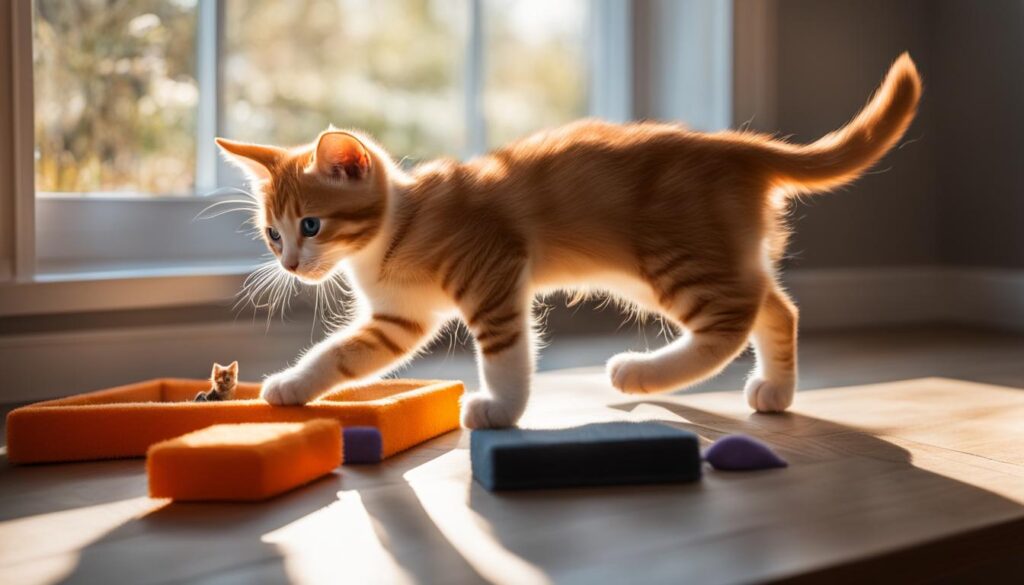
Creating a Play-Friendly Environment
Creating a play-friendly environment for your cat is crucial for their overall happiness and well-being. Cats have natural instincts to climb, scratch, and find elevated resting spots, and providing opportunities for these behaviors is essential.
Indoor Cat Trees
Indoor cat trees are a fantastic addition to any cat-friendly environment. They provide cats with vertical spaces to climb, explore, and perch on. Cat trees come in various sizes and designs, offering multiple platforms, scratching posts, and hiding spots that cats can enjoy. Placing a cat tree near a window allows cats to observe the outside world and engage with their natural curiosity. It also provides a safe and elevated spot for them to relax and feel secure.
Scratching Posts
Scratching is a natural behavior for cats that helps them condition their claws, mark territory, and stretch their bodies. Having appropriate scratching posts throughout your home is essential to redirect their scratching behavior away from furniture or carpets. Scratching posts should be tall enough for cats to fully stretch their bodies and sturdy enough to withstand their scratching. Consider different materials such as sisal, cardboard, or carpeted posts to find the one that your cat prefers. Place the scratching posts in areas where your cat spends time, ensuring they are easily accessible and appealing to your cat’s senses.
Elevated Resting Spots
Cats love to find elevated spots where they can observe their surroundings and feel safe. Providing elevated resting spots, such as shelves, window perches, or cat hammocks, gives your cat a sense of security and allows them to relax while still being part of the household activities. Cats also enjoy having multiple resting spots throughout your home, so consider placing comfortable beds or blankets in different favored locations. Creating cozy and inviting spots will help your cat feel comfortable and content in their environment.
By incorporating climbing structures, scratching posts, and elevated resting spots into your cat’s environment, you are creating a play-friendly space that allows them to engage in their natural behaviors. Remember, a happy and stimulated cat is a healthy and content cat.
| Benefits of Creating a Play-Friendly Environment | Examples |
|---|---|
| Provides mental and physical stimulation for cats | – Indoor cat trees – Scratching posts – Elevated resting spots |
| Reduces boredom and stress | – Multiple climbing opportunities – Vertical spaces for perching – Comfortable resting spots |
| Allows cats to engage in natural behaviors | – Scratching posts for claw conditioning – Elevated spots for observation and security – Climbing structures for exercise |
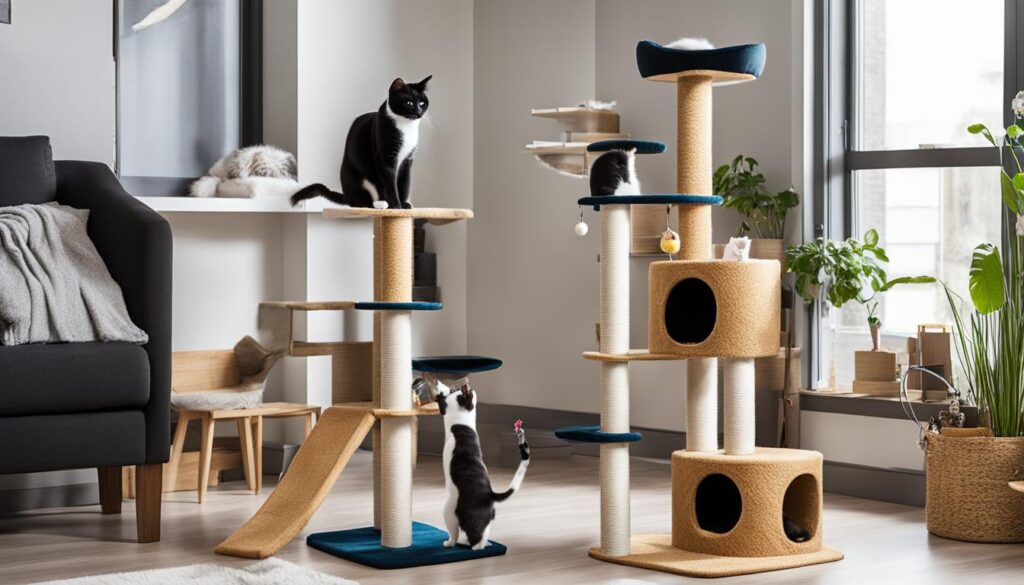
Playtime in Multi-Cat Households
When it comes to playtime in multi-cat households, social interaction is key. Cats are social animals, and engaging in play with their fellow felines can help build bonds, relieve tension, and provide mental and physical stimulation. However, it’s important to be aware of potential conflicts that may arise during play and to intervene if necessary.
Interventions in play between cats can be necessary to prevent escalation and potential injuries. By monitoring their behavior closely, you can identify signs of tension and step in to diffuse the situation. Using distractions, such as interactive toys like wand toys or laser pointers, can redirect their attention and help create a more positive play environment.
In some cases, cat play therapy may be beneficial in resolving conflicts and facilitating social play. This form of therapy involves structured play sessions supervised by a professional to address any underlying issues and foster positive interactions between cats. It can help cats build trust and develop appropriate play behaviors, ultimately strengthening their relationships.
Remember, each cat in a multi-cat household has unique preferences and personalities. It’s essential to provide opportunities for individual play as well, ensuring that every cat has a stress-free environment to enjoy their playtime. By promoting healthy and positive play between cats, you can create a harmonious atmosphere in your home.
Table: Common Interventions in Play between Cats
| Intervention | Description |
|---|---|
| Distraction | Using interactive toys like wand toys or laser pointers to redirect cats’ attention and diffuse tension during play. |
| Time-Out | Separating cats involved in play that has become too intense or aggressive to allow them to calm down. |
| Positive Reinforcement | Rewarding and praising cats for engaging in gentle and appropriate play behaviors. |
| Separation | Providing separate play areas or rotating play sessions between cats to prevent conflicts and give each cat individual attention. |
Conclusion
So there you have it – the captivating world of cat play! We’ve explored the numerous benefits of play for cats, from exercise and stress relief to relief from boredom and even bonding with their beloved owners. But what about when you can’t be there to supervise your furry friend’s playtime? Fear not, because there are safe cat toys that are perfect for unsupervised play.
One option is to opt for interactive toys that are specifically designed for solo play. These toys are typically made with durable materials and are designed to withstand the rough play of our feline friends. Some examples include puzzle toys that dispense treats or toys with built-in motion sensors that activate when a cat approaches. These toys keep cats engaged and entertained even when you’re not around.
If you’re feeling crafty, you can also try making homemade cat toys. Cats have a knack for finding joy in the simplest of things, so almost anything can become a toy in their curious minds. From crumpled-up paper balls to empty cardboard boxes, the possibilities are endless. Just make sure to avoid small, swallowable objects and choose materials that are safe for your kitty to play with.
Remember, play is an essential part of a cat’s life and contributes to their overall happiness and well-being. By providing safe toys for unsupervised play and introducing some homemade cat toy ideas, you can enrich your cat’s playtime experience and create a stronger bond with your feline companion. So go ahead, let the playtime adventure begin!
FAQ
Why is play important for cats?
Play is essential for the mental and physical well-being of cats. It provides important benefits such as exercise, stress relief, and relief of boredom.
What are some recommended interactive cat toys?
Some recommended interactive cat toys include mouse toys, ping pong balls, crinkle balls, motorized chase toys, and toys housed in tracks or loops.
How should I monitor my cat during play?
It is important to monitor your cat during play to prevent them from consuming non-food toys. Providing a variety of toys and rotating them regularly can help maintain your cat’s interest.
Are wand or fishing pole toys safe to use?
Wand or fishing pole toys are favorites of many cats, but should be used with caution to prevent entanglement or ingestion of string.
Can all cats enjoy catnip toys?
Catnip toys can be enjoyed by cats that respond positively to catnip, but should be avoided if they become agitated.
What are some tips for playtime with older cats?
It is important to adapt play sessions to suit an older cat’s level of mobility and keep them engaged. Gentle games can still be enjoyed.
How can I create a play-friendly environment for my cat?
Providing opportunities for climbing and perching, such as cat trees and climbing shelves, and offering scratching posts and a variety of resting spots can help create a play-friendly environment.
How should I handle playtime in multi-cat households?
It is important to monitor each cat’s behavior and consider individual play sessions. If play escalates to potential injury, distractions with interactive toys can help diffuse tension.


